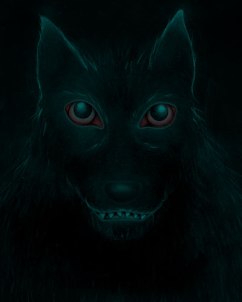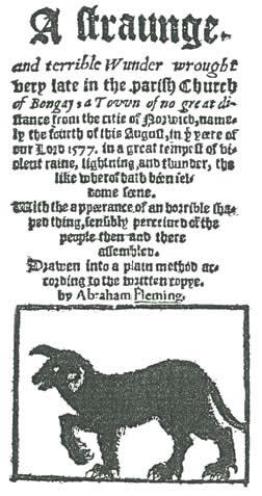I lived in England for a few years when I was little, and had an imaginary friend. If you’ve followed this blog for awhile, you might remember the Shadow People and the nightmare that scared me so badly. This was the counterpart to that. Some kids imagine happy-go-lucky playpals; I had a silent jaguar made of shadows. He was so real to me that I could almost make him out if I squinted in the dark.
Browsing for a monster interesting enough for a Halloween post, I came across a British phantom not unlike my long-lost companion. Given that this full moon is the Hunter’s moon, I figured the topic would be especially appropriate. Ladies and gentlemen, meet Black Shuck.

Liza Pheonix’s artist depiction, courtesy of Wikimedia Commons. (CC license 3.0)
There’s quite a bit on ole’ Shuck out there, as he’s been haunting Britain’s East Anglia (just northeast of London; coincidentally the area I lived in) since at least 1577. On August 8th of that year, during one of the worst storms in memory, an enormous black dog burst into a crowded Blythburg church. Racing through the panicked congregation, he killed two people and then made his escape, leaving scorch marks on the door. Almost at the same time in Bungay (a few towns over), the scene repeated itself with another black dog and another church and more of the faithful slaughtered. There’s a lovely rhyme that goes with the legend:
“All down the church in midst of fire, the hellish monster flew, and, passing onward to the quire, he many people slew.”*
The countryside erupted in terror. Was this demon canine a manifestation of the devil? Retribution for everyone’s sins? The Black Shuck obsession was born.
Though Shuck may have existed before–black dogs were common additions to the dark party of the Wild Hunt, and people accused of witchcraft were said to have called upon beasts much like him–after Blythburg, the legend really took off. For the next five centuries, people would see horrible hounds lurking in churchyards, blocking crossroads, peering out of bushes, bearing down roads. Shuck didn’t enter a church again, but seemed to be everywhere else. Anyone who laid eyes on him was doomed to death or misfortune. The fear was common enough that Conan Doyle picked up on it for The Hound of the Baskervilles.
Those unfortunate enough to behold Black Shuck described him as a hellhound. As his name suggests, he was entirely black, with ragged, matted fur (‘shucky’ colloquially meant shaggy or unkempt) and big, shining, red (or often red) eyes. He was usually large (could get as big as a calf), and was sometimes accompanied by clinking chairs or curling mist he might float on. Some people heard or felt him without seeing him directly. He surprised others by appearing without a head.
Mike Burgess’s site Shuckland analyzed 261 accounts of the creature (comprised of legends and actual encounters), and found that in most cases, Black Shuck would first appear to witnesses in rather ordinary (if creepy) ways. This included crossing their path, coming up behind them, or just appearing on the horizon, watching them get closer. Burgess notes that in such cases, people might not immediately realize what this black dog was, especially if his eyes weren’t glowing and he wasn’t floating or missing a head. Many times Shuck would ignore the witness entirely, but now and then he would follow them or become suddenly hostile.** Shuck’s exits were what really marked him as supernatural: he would stand unharmed as a car ran through him, or vanish into walls or shadows, or simply disappear into thin air.

Abraham Fleming’s original 1577 description, courtesy of Wikimedia Commons.
Black Shuck sightings do still happen now and again, but not with the regularity that they used to (encounters peaked in the early 20th century and then again in the 1970’s). Those who don’t believe in monsters blame the birth of his legend on a mishmash of leftover Nordic myths*** and tales spread by 16th-century clergymen looking to put a little fear of god in their peers. But recently surfaced evidence suggests that at least at one time, Black Shuck may have been terribly real.
In 2014, the bones of a very large dog–we’re talking 7 feet high on his hind legs–were unearthed in a shallow, unmarked grave under an abbey just a few miles from the original church attacks. Analysis revealed that the dog would have weighed over 200 pounds, and could have been buried between either 1650-1690, 1730-1810 or post 1920 (I know…I’m not sure how carbon dating works, either). All signs pointed to Shuck. Who so hastily buried this beast under the church? What damage was done before they could?
This Halloween, I wish you a new pet at least as exciting. I hope he does all kinds of tricks. Be it the shadow-jaguar of my childhood or a floating, headless hell beast, may your friendship be lively and your nights very, very long.
Happy haunting.
What sort of imaginary friends did you have as a child? Has any animal ever stuck to you a little too close? Share your story in the comments below.
*Presumably the author of this rhyme meant “fire” to signify either lightning, church candles, or an ethereal glow; as for “quire,”my guess would either be the bible or a literal “choir” (just spelled rather differently).
**Shuckland has a marvellous wealth of encounter descriptions; if you have a few hours to kill, I would recommend checking them out.
***Burgess disagrees with this theory.
Featured image by Victor Grabarczyk.





0 Comments